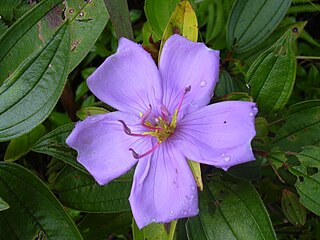
Melastoma is a genus in the family Melastomataceae. It has over 100 species distributed around Southeast Asia, India, north to Japan, south to Australia and the Pacific Islands. The number of species should probably be reduced according to some sources. Many species have been planted around the world for the aesthetic value of their bright purple flowers.

Spilomelinae is a very species-rich subfamily of the lepidopteran family Crambidae, the crambid snout moths. With 4,135 described species in 344 genera worldwide, it is the most speciose group among pyraloids.
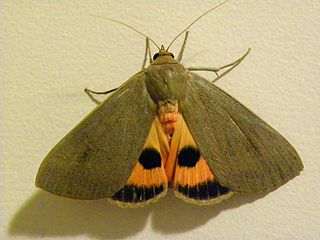
The Pyralini are a tribe of snout moths described by Pierre André Latreille in 1809. They belong to the subfamily Pyralinae, which contains the "typical" snout moths of the Old World and some other regions. The genus list presented here is provisional.

Ategumia is a genus of moths of the family Crambidae.

Parotis suralis is a moth of the family Crambidae. The species was first described by Julius Lederer in 1863. It is found around the west Pacific Rim, including the Chagos Islands, Hong Kong, Japan, Kiribati, Tuvalu and the tropical far north of Queensland.
Meganola brunellus is a moth of the family Nolidae. It is found in Sri Lanka, India, Taiwan, Japan, the Ryukyu Islands, Sundaland, Queensland and the Bismarck Islands. It is an introduced species in Hawaii.
Ategumia fatualis is a moth of the family Crambidae described by Julius Lederer in 1863. It is native to Java and the Philippines, but was introduced to Hawaii and Kauai in 1958 for the control of Melastoma malabathricum.

Agrotera basinotata is a moth of the family Crambidae described by George Hampson in 1891. It is native to Queensland, Thailand, Hong Kong and Japan, but was introduced to Hawaii for the control of Melastoma malabathricum.
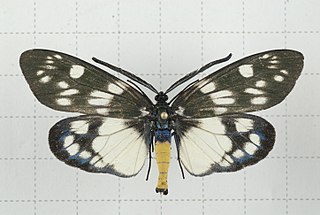
Eterusia aedea, the red slug caterpillar, is a species of moth in the family Zygaenidae. It was described by Carl Linnaeus in his 1763 Centuria Insectorum. It is found in Sri Lanka, India, Nepal, Taiwan, Japan and China.
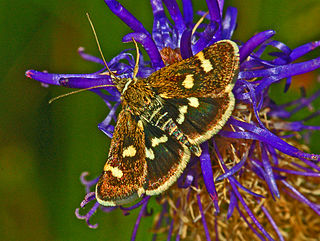
Odontiinae is a subfamily of moths of the family Crambidae. The subfamily was described by Achille Guenée in 1854.
Glyphodes doleschalii is a moth of the family Crambidae described by Julius Lederer in 1863. It is found in Queensland in northern Australia.

Glaphyriinae is a subfamily of the lepidopteran family Crambidae. It was described by William Trowbridge Merrifield Forbes in 1923. The subfamily currently comprises 509 species in 75 genera.
Ategumia insipidalis is a moth in the family Crambidae. It was described by Julius Lederer in 1863. It is found in Colombia.
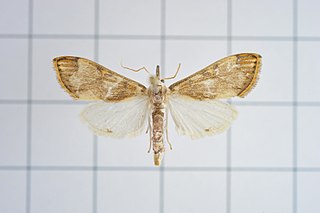
Cirrhochrista fuscusa is a moth in the family Crambidae. It was described by Fu-Qiang Chen, Shi-Mei Song and Chun-Sheng Wu in 2006. It is only found in Taiwan. This genus is extensively distributed in tropical and subtropical Africa, throughout tropical Asia to China, Japan, India, Madagascar and Australia.

Cydalima pfeifferae is a moth in the family Crambidae. It was described by Julius Lederer in 1863. It is found in India, Myanmar, Singapore, Indonesia, Taiwan and Australia, where it has been recorded on Queensland.
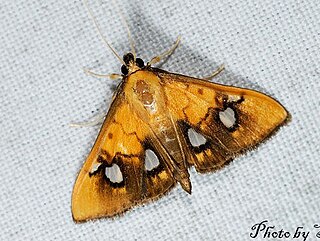
Nosophora semitritalis is a species of moth in the family Crambidae. It was described by Julius Lederer in 1863. It is found in China, Thailand, Taiwan and Japan.

Odonestis bheroba is a moth of the family Lasiocampidae first described by Frederic Moore in 1858.
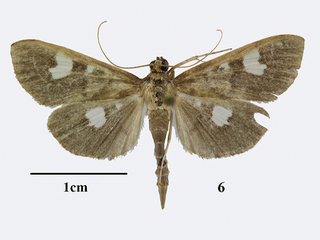
Agroterini is a tribe of the species-rich subfamily Spilomelinae in the pyraloid moth family Crambidae. The tribe was erected by Alexandre Noël Charles Acloque in 1897.

Margaroniini is a tribe of the species-rich subfamily Spilomelinae in the pyraloid moth family Crambidae. The tribe was erected by Charles Swinhoe and Everard Charles Cotes in 1889, originally as family Margaronidae.

Nomophilini is a tribe of the species-rich subfamily Spilomelinae in the pyraloid moth family Crambidae. The tribe was erected by Vladimir Ivanovitsch Kuznetzov and Alexandr A. Stekolnikov in 1979.
















